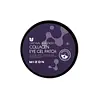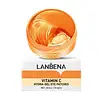What's inside
What's inside
 Key Ingredients
Key Ingredients

 Benefits
Benefits

 Concerns
Concerns

 Ingredients Side-by-side
Ingredients Side-by-side

Water
Skin ConditioningGlycerin
HumectantChondrus Crispus Extract
Skin ConditioningCeratonia Siliqua Gum
EmollientCellulose Gum
Emulsion StabilisingHydroxyacetophenone
Antioxidant1,2-Hexanediol
Skin ConditioningSucrose
HumectantPotassium Chloride
Allantoin
Skin ConditioningXanthan Gum
EmulsifyingEthylhexylglycerin
Skin ConditioningCalcium Aluminum Borosilicate
CI 77007
Cosmetic ColorantAdenosine
Skin ConditioningBis-PEG-15 Methyl Ether Dimethicone
EmulsifyingDisodium EDTA
Calcium Lactate
AstringentCI 77891
Cosmetic ColorantSilica
AbrasiveMica
Cosmetic ColorantHydrolyzed Collagen
EmollientDipotassium Glycyrrhizate
HumectantSodium Polyacryloyldimethyl Taurate
Emulsion StabilisingPolyglyceryl-4 Caprate
EmulsifyingPolyglyceryl-6 Caprylate
EmulsifyingDipalmitoyl Hydroxyproline
Skin ConditioningPEG-60 Hydrogenated Castor Oil
EmulsifyingButylene Glycol
HumectantPalmitic Acid
EmollientParfum
MaskingPortulaca Oleracea Extract
Skin ConditioningChamomilla Recutita Flower Extract
MaskingCaviar Extract
Skin ConditioningPhenoxyethanol
PreservativeTocopherol
AntioxidantWater, Glycerin, Chondrus Crispus Extract, Ceratonia Siliqua Gum, Cellulose Gum, Hydroxyacetophenone, 1,2-Hexanediol, Sucrose, Potassium Chloride, Allantoin, Xanthan Gum, Ethylhexylglycerin, Calcium Aluminum Borosilicate, CI 77007, Adenosine, Bis-PEG-15 Methyl Ether Dimethicone, Disodium EDTA, Calcium Lactate, CI 77891, Silica, Mica, Hydrolyzed Collagen, Dipotassium Glycyrrhizate, Sodium Polyacryloyldimethyl Taurate, Polyglyceryl-4 Caprate, Polyglyceryl-6 Caprylate, Dipalmitoyl Hydroxyproline, PEG-60 Hydrogenated Castor Oil, Butylene Glycol, Palmitic Acid, Parfum, Portulaca Oleracea Extract, Chamomilla Recutita Flower Extract, Caviar Extract, Phenoxyethanol, Tocopherol
Water
Skin ConditioningGlycerin
HumectantCarrageenan
3-O-Ethyl Ascorbic Acid
Skin ConditioningSodium Hyaluronate
HumectantNiacinamide
SmoothingCeratonia Siliqua Gum
EmollientHydrolyzed Collagen
EmollientDipropylene Glycol
HumectantButylene Glycol
HumectantArnica Montana Flower Extract
MaskingTocopheryl Acetate
AntioxidantAdenosine
Skin ConditioningAllantoin
Skin ConditioningCaffeine
Skin ConditioningXanthan Gum
EmulsifyingPEG-60 Hydrogenated Castor Oil
EmulsifyingCeramide NP
Skin ConditioningChamomilla Recutita Flower Extract
MaskingPhenoxyethanol
PreservativeMica
Cosmetic ColorantParfum
MaskingCI 19140
Cosmetic ColorantWater, Glycerin, Carrageenan, 3-O-Ethyl Ascorbic Acid, Sodium Hyaluronate, Niacinamide, Ceratonia Siliqua Gum, Hydrolyzed Collagen, Dipropylene Glycol, Butylene Glycol, Arnica Montana Flower Extract, Tocopheryl Acetate, Adenosine, Allantoin, Caffeine, Xanthan Gum, PEG-60 Hydrogenated Castor Oil, Ceramide NP, Chamomilla Recutita Flower Extract, Phenoxyethanol, Mica, Parfum, CI 19140
Ingredients Explained
These ingredients are found in both products.
Ingredients higher up in an ingredient list are typically present in a larger amount.
Adenosine is in every living organism. It is one of four components in nucleic acids that helps store our DNA.
Adenosine has many benefits when used. These benefits include hydrating the skin, smoothing skin, and reducing wrinkles. Once applied, adenosine increases collagen production. It also helps with improving firmness and tissue repair.
Studies have found adenosine may also help with wound healing.
In skincare products, Adenosine is usually derived from yeast.
Learn more about AdenosineAllantoin is a soothing ingredient known for its protective and moisturizingg properties. Because of this, it is often added to products with strong active ingredients.
Studies show higher concentrations of this ingredient can promote wound healing.
Though it can be derived from the comfrey plant, allantoin is produced synthetically for cosmetic products to ensure purity.
Learn more about AllantoinButylene Glycol (or BG) is used within cosmetic products for a few different reasons:
Overall, Butylene Glycol is a safe and well-rounded ingredient that works well with other ingredients.
Though this ingredient works well with most skin types, some people with sensitive skin may experience a reaction such as allergic rashes, closed comedones, or itchiness.
Learn more about Butylene GlycolCeratonia Siliqua Gum is extracted from the seeds of the carob tree. You might know this ingredient as Carob Gum or Locust Bean Gum. It is used to stabilize other ingredients and improve the texture of products.
Carob gum is made up of long-chain polysaccharides. This makes it a natural thickener.
Yes! This ingredient comes from the seeds of a tree. The name 'Locust Bean Gum' can be misleading.
Learn more about Ceratonia Siliqua GumChamomilla Recutita Flower Extract comes from the Chamomile flower.
Chamomile is rich in antioxidants and has anti-inflammatory properties. Several compounds found in chamomile help with soothing, such as bisbolol.
Antioxidant components in chamomile make it an effective ingredient to help slow the signs of aging. Antioxidants help fight free-radical molecules, or molecules that may damage your skin.
Essential oils from chamomile have been found to improve wound healing due to its antimicrobial properties.
Ancient Greeks and Egyptians used Chamomile to treat skin redness and dryness. Chamomile has also been used to help treat stomach issues.
Learn more about Chamomilla Recutita Flower ExtractGlycerin is already naturally found in your skin. It helps moisturize and protect your skin.
A study from 2016 found glycerin to be more effective as a humectant than AHAs and hyaluronic acid.
As a humectant, it helps the skin stay hydrated by pulling moisture to your skin. The low molecular weight of glycerin allows it to pull moisture into the deeper layers of your skin.
Hydrated skin improves your skin barrier; Your skin barrier helps protect against irritants and bacteria.
Glycerin has also been found to have antimicrobial and antiviral properties. Due to these properties, glycerin is often used in wound and burn treatments.
In cosmetics, glycerin is usually derived from plants such as soybean or palm. However, it can also be sourced from animals, such as tallow or animal fat.
This ingredient is organic, colorless, odorless, and non-toxic.
Glycerin is the name for this ingredient in American English. British English uses Glycerol/Glycerine.
Learn more about GlycerinHydrolyzed collagen has a misleading name because it is actually a mixture of various proteins/peptides. This ingredient has skin hydrating properties.
Collagen is the most abundant type of structural protein found in your body. In your skin, it is responsible for keeping it firm and youthful.
Hydrolyzed Collagen is created by breaking up proteins into smaller peptide bonds. These peptides act as humectants and emollients.
Humectants are great at holding onto water, keeping skin hydrated. Emollients create a thin barrier on the skin to prevent moisture from escaping.
There is ongoing debate about whether hydrolyzed collagen works because it increases skin hydration. Skin hydration is also linked to elasticity and the appearance of wrinkles.
Collagen or peptide ingredients can be used in the morning or night. They will not increase sun sensitivity, but you should always wear sunscreen during the day.
According to a manufacturer, this ingredient is a great hair conditioner as well.
This ingredient can be extracted from different sources, including:
Vegan collagen is derived from yeast, bacteria, or plant sources. Vegan collagen would go by a different INCI name, such as hydrolyzed soy protein.
The results are varied.
A study from 2021 found hydrolyzed collagen increased elasticity and improved wrinkles in 1,125 participants between age 20 and 70. Another study found increased skin thickness in participants between the ages of 45 to 59.
However, It is difficult to prove that oral collagen will end up working on your skin. Many of the studies using hydrolyzed collagen also add several vitamins and nutrients into the test mixture as well.
Further studies are needed at this time.
Learn more about Hydrolyzed CollagenMica is a naturally occurring mineral used to add shimmer and color in cosmetics. It can also help improve the texture of a product or give it an opaque, white/silver color.
Serecite is the name for very fine but ragged grains of mica.
This ingredient is often coated with metal oxides like titanium dioxide. Trace amounts of heavy metals may be found in mica, but these metals are not harmful in our personal products.
Mica has been used since prehistoric times throughout the world. Ancient Egyptian, Indian, Greek, Roman, Aztec, and Chinese civilizations have used mica.
Learn more about MicaParfum is a catch-all term for an ingredient or more that is used to give a scent to products.
Also called "fragrance", this ingredient can be a blend of hundreds of chemicals or plant oils. This means every product with "fragrance" or "parfum" in the ingredients list is a different mixture.
For instance, Habanolide is a proprietary trade name for a specific aroma chemical. When used as a fragrance ingredient in cosmetics, most aroma chemicals fall under the broad labeling category of “FRAGRANCE” or “PARFUM” according to EU and US regulations.
The term 'parfum' or 'fragrance' is not regulated in many countries. In many cases, it is up to the brand to define this term.
For instance, many brands choose to label themselves as "fragrance-free" because they are not using synthetic fragrances. However, their products may still contain ingredients such as essential oils that are considered a fragrance by INCI standards.
One example is Calendula flower extract. Calendula is an essential oil that still imparts a scent or 'fragrance'.
Depending on the blend, the ingredients in the mixture can cause allergies and sensitivities on the skin. Some ingredients that are known EU allergens include linalool and citronellol.
Parfum can also be used to mask or cover an unpleasant scent.
The bottom line is: not all fragrances/parfum/ingredients are created equally. If you are worried about fragrances, we recommend taking a closer look at an ingredient. And of course, we always recommend speaking with a professional.
Learn more about ParfumPeg-60 Hydrogenated Castor Oil comes from hydrogenated castor oil. It is a solubilizer and emulsifier.
As a solubilizer, it helps dissolve ingredients into a water-based version. It is also an emulsifer. Emulsifier help prevent oils and water from separating. Both these properties help create evenly-spread and uniform products.
Basically, Peg-60 Hydrogenated Castor Oil helps hold ingredients together.
Learn more about PEG-60 Hydrogenated Castor OilPhenoxyethanol is a preservative that has germicide, antimicrobial, and aromatic properties. Studies show that phenoxyethanol can prevent microbial growth. By itself, it has a scent that is similar to that of a rose.
It's often used in formulations along with Caprylyl Glycol to preserve the shelf life of products.
Water. It's the most common cosmetic ingredient of all. You'll usually see it at the top of ingredient lists, meaning that it makes up the largest part of the product.
So why is it so popular? Water most often acts as a solvent - this means that it helps dissolve other ingredients into the formulation.
You'll also recognize water as that liquid we all need to stay alive. If you see this, drink a glass of water. Stay hydrated!
Learn more about WaterXanthan gum is used as a stabilizer and thickener within cosmetic products. It helps give products a sticky, thick feeling - preventing them from being too runny.
On the technical side of things, xanthan gum is a polysaccharide - a combination consisting of multiple sugar molecules bonded together.
Xanthan gum is a pretty common and great ingredient. It is a natural, non-toxic, non-irritating ingredient that is also commonly used in food products.
Learn more about Xanthan Gum